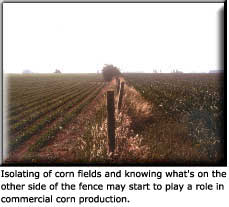
Preserving Your Corn's Identity
 Seed
corn and waxy corn growers have been segregating and preserving the identity
of their corn crops for years. Concerns over the marketing of genetically
enhanced (GE) corn has sparked increasing levels of interest in identity preservation
systems in commercial corn. This fall we are in the midst of segregating out
those hybrids that contain GE events which are not approved in the European
Union. What are the principal questions and/or concerns in regards to identity
preservation of corn this fall and beyond?
Seed
corn and waxy corn growers have been segregating and preserving the identity
of their corn crops for years. Concerns over the marketing of genetically
enhanced (GE) corn has sparked increasing levels of interest in identity preservation
systems in commercial corn. This fall we are in the midst of segregating out
those hybrids that contain GE events which are not approved in the European
Union. What are the principal questions and/or concerns in regards to identity
preservation of corn this fall and beyond?
What are you
planting?
Late April of this year was marked by a whirlwind of confusion regarding genetic
events, European non-approved hybrids and marketing options for these hybrids.
In the future, hybrid selection will need to be based carefully on genetic
traits because of their agronomic importance to your farm operation and because
of the marketing implications. It won’t be enough to select Bt versus
non-Bt; you will need to keep track of specific hybrids that contain Bt events
that do not restrict your markets. Keeping accurate records of hybrid traits,
selecting suitable hybrids, and planting these hybrids with a scrupulously
clean corn planter may all become part of identity preservation in commercial
corn production.
Where are
you planting?
The need to more carefully
consider field location will also enter into the identity preservation system.
Since corn is a cross-pollinating crop the risk of harvesting corn with traits
other than those planted is real. Isolation distances in seed corn production
are set at 200 metres to ensure very low levels of contamination from neighbouring
pollen. Removal of the outside rounds from a field generally goes a long way
to maintaining the purity of the corn harvested from the remaining portion
of the field. The problem with trying to finalize any particular approach
for isolating GE corn is that we don’t know what tolerance level will
be acceptable to those who prefer to purchase non-GE corn. At two per cent
tolerance levels (i.e., two per cent GE in a non-GE truck load) we could probably
make it work with approaches similar to seed or waxy corn production; at 0.1
per cent the influences of wind borne pollen would make the task of identity
preservation daunting.
What are you
delivering?
Verification that what you
say you are delivering is actually what you are delivering perhaps becomes
the highest hurdle in identity preservation of GE corn. Presently the tests
for the various genetic events require expensive sophisticated lab work. There
are efforts to produce more economical kits for testing at the farm or elevator
level. However, for this fall the only kits available for corn detect EU-approved
Bt events. There are no quick tests yet available for Roundup Ready, Liberty
Link or other Bt events. The other problem is that these test strips may use
a different tolerance level than that imposed by the end user or purchaser
of the corn and thus be proven invalid. The future will no doubt bring additional
testing abilities to verify corn identity.
Towards 2000
Here are two suggestions
for preparing for future developments in the growing and marketing of corn.